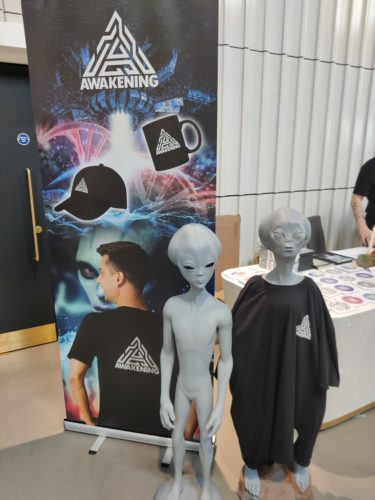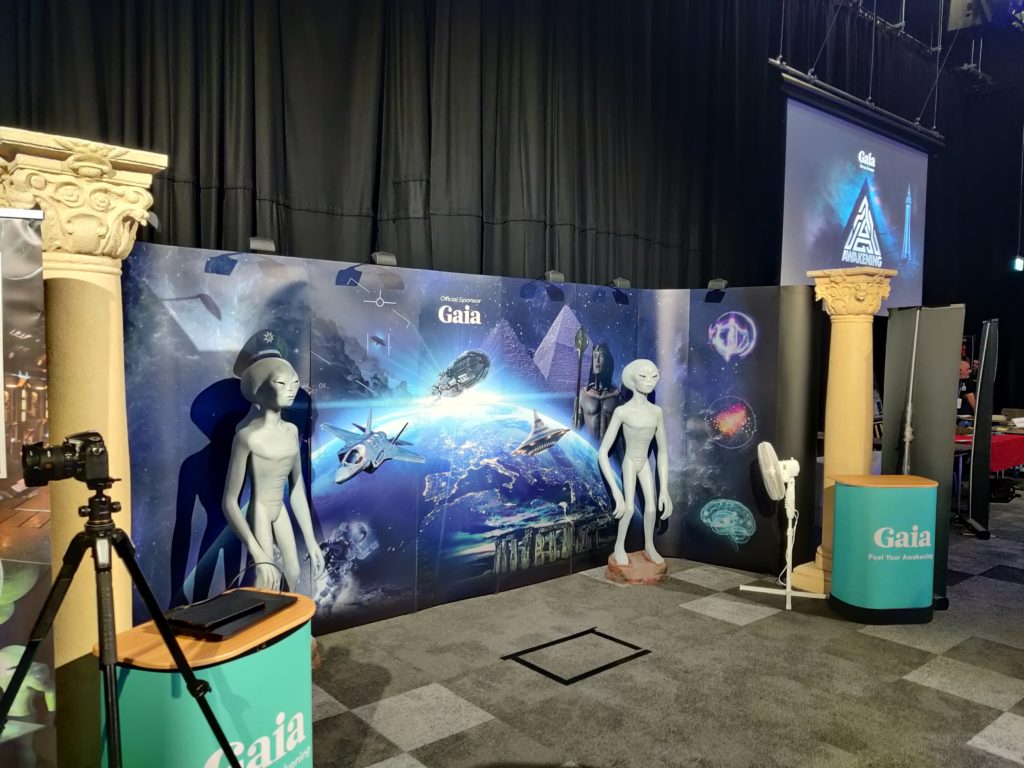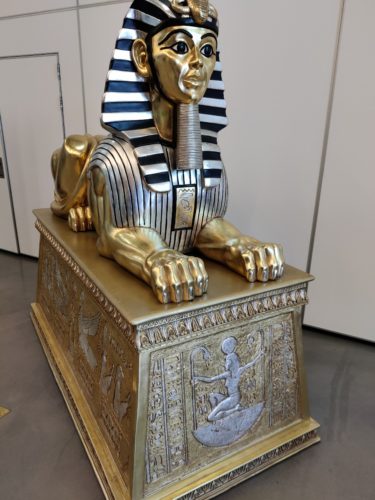For the 22% of Brits who believe that aliens exist and have visited Earth, one event this summer may have had a special appeal: the Awakening Expo 2022, held in the northern English seaside town of Blackpool.
Two of the biggest stars from TV “documentary” series Ancient Aliens, Erich von Däniken and Giorgio A Tsoukalos, joined a host of other guests for a weekend of “Ancient Mysteries, Extra-terrestrials, Secret Space Programs, the World of Cryptids & Giants, Space Anomalies, Forgotten Cultures & Lost Civilizations.”
As a Skeptic living not too far from Blackpool, I felt it my duty to attend, and I was surprised by at least some of what I found. Long-standing readers may recall that I have previously written on the ancient astronauts hypothesis, in an article that focused on plans to build a Chariots of the Gods Entertainment Park in Blackpool itself – branding that has since been abandoned as apparently it does not resonate with younger audiences, though the park will remain true to von Däniken’s book inside.

After the last few years, during which conspiracy theorists have risked public health during a pandemic and played a part in upsetting democratic and civic values, I was more than a little trepidatious about attending a gathering like Awakenings Expo 2022. I need not have worried about the attendees or stallholders, all of whom were polite and pleasant to chat with, and who did not, as far as I could see, wear any QAnon or similar t-shirts.
I was more surprised to find that the two stars of the show seem to have paid at least some attention to the public criticism that their ancient astronauts theory has attracted, and are attempting to draw clear distinctions between their beliefs, which they claim are scientific, and those of other conspiracy believers, which they sharply critiqued.
The ancient astronauts theory has been attacked as having racist undertones, as it credits aliens with the design or technology for the construction of ancient wonders such as the pyramids of Egypt and Moai statues of Easter Island, which as museum curator and archaeologist Keith Fitzpatrick-Matthews puts it, comes with an “underlying and unspoken racist assumption: the benighted savages of distant continents and ancient times could not possibly have been responsible for the remarkable ruined structures found in their lands.” This was directly addressed at the conference, with Tsoukalos pointing out that they were not just referring to non-European cultures as having been visited by ancient astronauts, but also to the Norse pantheon, to Stonehenge, and so forth.
Indeed Tsoukalos and von Däniken shared several talking points, particularly around the means by which the ancient astronauts could have visited the entire galaxy in only 10 million years, using generation ships and without any miraculous FTL technology. While their understanding of the size of space and the timescales involved in the history of the universe does give them more credit than the writers of a lot of science fiction shows deserve, I’d note that this makes alien visitation plausible, not proven.
It is possible that this more recent association with Tsoukalos has had a good influence on von Däniken, who we should not forget wrote in his 1979 book, Signs of the Gods:
The evolutionists say that man descends from monkeys. Yet who has ever seen a white monkey? Or a dark ape with curly hair such as the black race has? … Was the black race a failure and did the extraterrestrials change the genetic code by gene surgery and then programme a white or a yellow race?
I’m all for people making positive changes to their worldview, and perhaps von Däniken now sincerely regrets these words, but if he does, I’ve not heard or seen him express that explicitly.
Still, it was a genuinely pleasant experience to hear Tsoukalos in particular steer the conversation toward a somewhat more rational direction. At one point he suggested any flat earthers in the room should leave – to much applause – and later on pointed out that the lines of vapour in the sky left by aircraft are contrails, not chemtrails (this latter point did not receive such a warm reception from the audience).
Tsoukalos finished his talk by saying that it was absurd to worry about the specific appearance (“what underwear”) or origin (“what planet”) of ancient aliens. I took this to mean that anyone writing or speaking about such things was making up stories, which would presumably come as a surprise to some of the other speakers at the Expo: Richard Doty had a picture of an extra-terrestrial; Jonny Enoch spoke of a still-working stargate and of specific alien races; and Dr Theresa Bullard-Whyke had a very specific theory around the number of parallel universes and planets that we are connected to.
In his talk later on the Sunday, von Däniken also pointed out much the same idea about the silliness of such arguments, before fundamentally undercutting it by saying that “Gods made us in their image and we are their offspring,” which I felt harked back to the ideas he espoused in his earlier Signs of the Gods.
Still, if we do stop worrying about the details of alien appearance, unrelated conspiracy theories, and the (unpleasant) politics of such claims, and just focus on the substance of the arguments proposed in favour of ancient astronauts: is there any evidence or argument presented by either speaker that merits more serious consideration, and has not already been debunked by professional archaeologists?
Giorgio Tsoukalos spoke about the “Tolima fighter jets” – found among the extant gold and ceramic Quimbaya artefacts, which were created 1,500 years ago by a civilisation in Colombia. A small number of the hundreds of exquisite depictions – mostly of humans, plants, birds, insects, fish and bats – could reasonably be said to resemble fighter jets.
He said that this goes beyond a passing resemblance, and added that their wings attach at the bottom, like modern aircraft but unlike any real flying animal found in nature. However, as geologist Tim Callahan and palaeontologist Donald Prothero point out in their book UFOs, Chemtrails, and Aliens: What the Science Says, the “jet fighters” also closely resemble the Suckermouth Catfish.
He also said that researchers had built models that were just scaled-up from these artefacts and actually flew – but from what I’ve seen these recreations took liberties, not least in removing a lot of the stylisations and flourishes from the originals.
Finally, as blogger Archaeological Fantasies says, the ancient jets theory just doesn’t add up:
But honestly, let’s look at the larger issue with this whole ancient airplane thing, Where are the remains of these planes? Where are the parts, the broken bits, the actual plane themselves? Where is all the stuff associated with flying planes? Where are the airports, the air towers, the luggage claim racks…
If man was making them, where are the production sites? If Aliens flew them down, why is there no physical evidence? What did these things run on? Jet fuel is an expensive, complicated, explosive mix. How did our ancestors make it and not kill themselves?
Tsoukalos also spoke about the Puma Punku complex in Bolivia. Also dating back 1,500 years, this time to the Tiwanaku Empire, these monumental ruins include finely-carved blocks, meticulous foundations and precisely cut ornamental stones. To my eye some of the carvings strongly resemble designs used for the ancients in the Assassin’s Creed video games, which I am sure is intentional, as that series of games borrows from a wide variety of real history, popular mythology and outright conspiracy theories.
Tsoukalos said that even iron and copper tools are not strong enough to make such cuts to these grey andesite stones found at Puma Punku, and that chicken bones, which he says are the official explanation, could not possibly be responsible for creating these perfect grooves and holes with equidistant depth. He added that 10-75 ton red sandstone blocks are found above the tree line, so how did they get up there? Finally, the H-shaped blocks stack perfectly, just like Lego, and interlock.
It can be hard to fact-check a lecture, and I have no idea whether he was joking about the chicken bones, but certainly the Wankarani people, predecessors to the Tiwanaku in the Bolivian highlands, used copper, and there’s evidence of multiple cultures having access to bronze in South America around the time Puma Punku was constructed. There’s little mystery among mainstream archaeologists as to how these rocks were fashioned.
How did they move rocks above the tree-line? They cut the trees down below the tree line and then used them – with the help of ropes.
And the perfectly stacking H blocks? They’re built to a plan, but are not identical, and so do not stack perfectly.
I could go on at length regarding Tsoukalos’ claims, but I’ll finish with him on his insistence that ancient artworks showing the gods above – such as in a sky palace in an Indian work – are realistic depictions, and that we should take them as literal representations of real events. This is simply absurd. Artistic traditions of course vary massively across the world throughout history, but there have always been conventions that are not strictly representational; art focusing on story or symbolism; art focused on depictions of sacred and ancient texts; and art that shows scenes which even if taken as real were not witnessed by the artist. For much of history, completely accurate and realistic representations in art were not the priority.

With no convincing evidence from the younger TV star of the theory, what of the great populariser of Chariots of the Gods, Erich von Däniken himself?

Von Däniken went for some greatest hits. Firstly, that the Dogon people of Mali had a centuries-old tradition of extraterrestrial contact and awareness of Sirius B, a star that’s invisible to the naked eye and was not discovered until 1862. How, he asks, could they have known about Sirius B, without alien contact?
The theory dates back to at least the 1976 book The Sirius Mystery and is based on observations of early 20th century French ethnographers, Marcel Griaule and Germaine Dieterlen. Not only were there other ways that Sirius B’s existence could have been made known to the Dogon during a visit prior to Griaule and Dieterlen – by French astronomers in the late 19th century – but no other anthropologist found evidence of knowledge of Sirius B among the Dogon people at all. The most damning account comes from Walter Van Beek:
In 1991, Van Beek led a team of anthropologists to Mali and declared that they found absolutely no trace of the detailed Sirius lore reported by the French anthropologists… Van Beek could find no trace of it in the decade he spent with the Dogon. Van Beek actually spoke to some of Griaule’s original informants; he noted that “though they do speak about sigu tolo [interpreted by Griaule as their name for Sirius itself], they disagree completely with each other as to which star is meant; for some, it is an invisible star that should rise to announce the sigu [festival], for another it is Venus that, through a different position, appears as sigu tolo. All agree, however, that they learned about the star from Griaule. [Emphasis mine]
So: a theory that’s not only without any evidence, but that was possibly started – maybe unintentionally – by the very anthropologist who supposedly discovered it!
Next up, the Antikythera mechanism – a 2,000 year old advanced orrery – or an early analogue computer – that can predict astronomical positions and eclipses. Certainly everyone can agree that it is a stunning finding, a technological achievement that was unsurpassed for more than a thousand years, but it did not arrive without context – Cicero writes of other examples – and it only includes the known planets at the time. If it were inspired somehow by alien knowledge, where are Neptune and Uranus? This is not proof of extraterrestrial contact.
Also reheated from Chariots of the Gods is the Piri Reis map. This 500 year old map is a pretty accurate depiction of some of the coast of South America, North Africa and Europe, and a number of islands in the Atlantic. Von Däniken said the presence of the Antarctic coast on the map, and the correct location of islands that are now under ice, is surely proof of advanced – and by implication extraterrestrial – knowledge. Unless, of course, you consider some obvious and rather large inconsistencies, as cartography historian Gregory McIntosh does:
As far as the accuracy of depiction of the supposed Antarctic coast is concerned, there are two conspicuous errors. First, it is shown hundreds of miles north of its proper location; second, the Drake Passage is completely missing, with the Antarctic Peninsula presumably conflated with the Argentine coast. The identification of this area of the map with the frigid Antarctic coast is also difficult to reconcile with the notes on the map which describe the region as having a warm climate.

After a few more stories about various religious traditions definitely being about gods and not about religion – a man in the audience disagreed strongly around this point, shouting “Jesus is Lord!”, a rare heckle from the very well-behaved crowd – his finale was the existence of secret lakes under the Giza Plateau, which he says were recently discovered but not widely reported. The press has in fact covered the discovery of various mysterious deep voids in the complex, some of which do contain water.
Von Däniken showed us some photos from his visit, which were not unlike those in this ancient origins article. Apparently, ancient writings foretold the existence of black sarcophagi in these deep chambers, and when they pumped them out, they found black sarcophagi, and these were empty.
I’m genuinely unsure what he thinks this proves. The water level is not constant and such chambers were not always full of water – for example, a dam built in the 2000s raised the groundwater – and grave robbing has been a problem ever since tombs were constructed. There’s plenty that remains very mysterious and unknown about the pyramids, but none of it requires an extraterrestrial explanation.
As Erich von Däniken was signing off, he said that we have to change the spirit of the time, because the science community won’t look at such evidence, and “even if the pope had a chat with ETs people wouldn’t believe.”
While it is true that I wouldn’t take the word of a religious figure as proof of alien visitation, I would take some good evidence. I didn’t see any at Awakenings Expo 2022, though I did have a nice day out in Blackpool.


